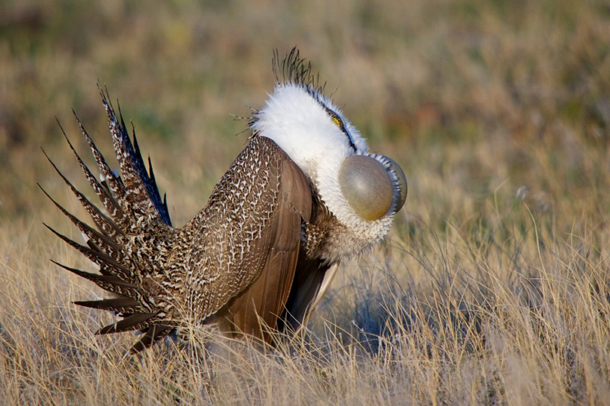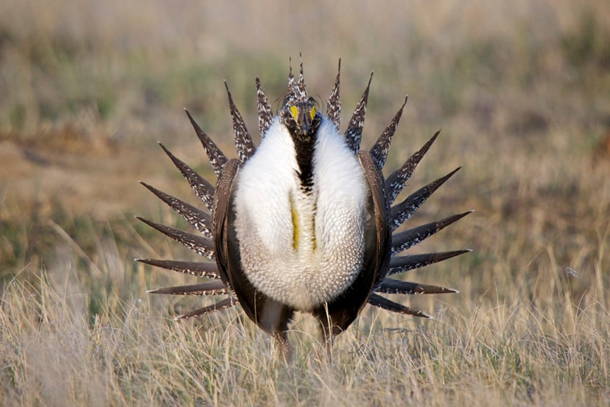BirdNote®: Sage Grouse Lek and Grasslands
Air Date: Week of April 12, 2019

The greater Sage Grouse performing its famous mating display. (Photo: Randy Kokesch)
Springtime brings spectacular courtship dances by the male Greater Sage Grouse, which sings a remarkable song as it puffs up its two bulbous air sacs and moves its head back and forth in order to attract a mate. BirdNote’s Michael Stein reports on the bird’s curious practice called leks, and how Sage Hens are threatened by agricultural and energy development.
Transcript
[BIRDNOTE THEME]
CURWOOD: The Fish and Wildlife report concluded that pesticides can multiply the risks for species in decline. The Greater Sage Grouse is not listed as endangered but there’s just a fraction of them remaining in the wild as compared to a century ago. And as Bird Note’s Michael Stein reports, the Greater Sage Grouse is perhaps most well-known for its unique mating call and dance.
STEIN: Dawn breaks across the sagebrush country of the West on a brisk March morning.
[SAGE-GROUSE MALES PERFORMING]
Already, fifteen male Greater Sage-Grouse are strutting on their traditional display area, a sparsely vegetated arena amid the sage.
[SAGE-GROUSE MALES PERFORMING]
As the sun rises, meadowlarks begin to sing.
[WESTERN MEADOWLARK SONG]
And we can now see the Sage-Grouse clearly. The enormous males are over two feet long, and weigh six pounds. They stand bolt upright, their long tails fanned like a turkey’s tail, the dark backs and bellies contrasting sharply with their white breasts. When they display, the sage-grouse simultaneously scrape their wings back and forth against their flanks, expel air from twin, fleshy chest-sacs the size of tennis balls, and call softly. The resulting sound combines swishing, popping, and cooing.
[SOUNDS OF SAGE-GROUSE MALES PERFORMING ON LEK]
At the display area, known as a lek, the male Sage-Grouse perform for mating rights with the smaller females looking on.
[SOUNDS OF SAGE-GROUSE MALES PERFORMING ON LEK]

Female sage grouse often return to the same mate every year, leaving males without a partner, despite their flashy mating rituals. (Photo: Randy Kokesch)
As lands formerly covered in sage are converted to agriculture, so goes the fate of the magnificent Sage-Grouse. In some areas, the grouse have less than ten percent of their historical range.
[SOUNDS OF SAGE-GROUSE MALES PERFORMING ON LEK]
I’m Michael Stein.
CURWOOD: For photos of the Greater Sage Grouse strut on over to our website, LOE.ORG.
[Written by Bob Sundstrom
Bird sounds provided by The Macaulay Library of Natural Sounds at the Cornell Lab of Ornithology,
Ithaca, New York. Display sounds of the Greater Sage-Grouse recorded by G.A. Keller; call of the Western Meadowlark recorded by W.R. Fish
Producer: John Kessler
Executive Producer: Chris Peterson
© 2013 Tune In to Nature.org March 2013 Narrator: Michael Stein]
Links
Living on Earth wants to hear from you!
Living on Earth
62 Calef Highway, Suite 212
Lee, NH 03861
Telephone: 617-287-4121
E-mail: comments@loe.org
Newsletter [Click here]
Donate to Living on Earth!
Living on Earth is an independent media program and relies entirely on contributions from listeners and institutions supporting public service. Please donate now to preserve an independent environmental voice.
NewsletterLiving on Earth offers a weekly delivery of the show's rundown to your mailbox. Sign up for our newsletter today!
 Sailors For The Sea: Be the change you want to sea.
Sailors For The Sea: Be the change you want to sea.
 The Grantham Foundation for the Protection of the Environment: Committed to protecting and improving the health of the global environment.
The Grantham Foundation for the Protection of the Environment: Committed to protecting and improving the health of the global environment.
 Contribute to Living on Earth and receive, as our gift to you, an archival print of one of Mark Seth Lender's extraordinary wildlife photographs. Follow the link to see Mark's current collection of photographs.
Contribute to Living on Earth and receive, as our gift to you, an archival print of one of Mark Seth Lender's extraordinary wildlife photographs. Follow the link to see Mark's current collection of photographs.
 Buy a signed copy of Mark Seth Lender's book Smeagull the Seagull & support Living on Earth
Buy a signed copy of Mark Seth Lender's book Smeagull the Seagull & support Living on Earth

